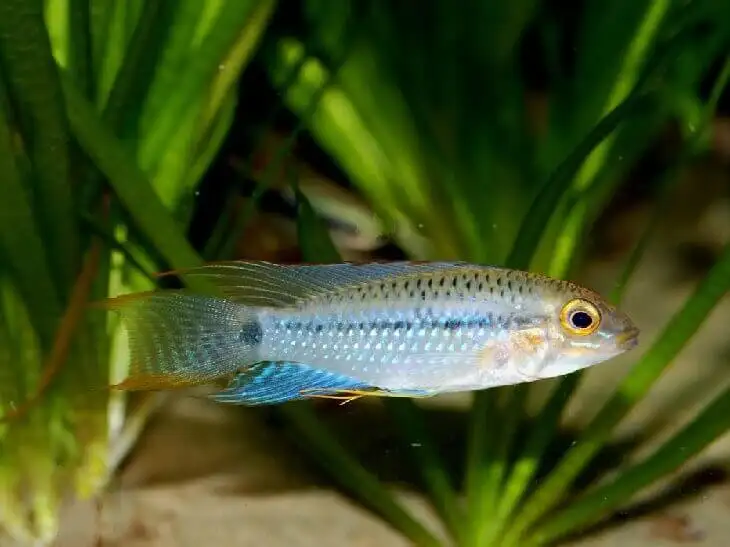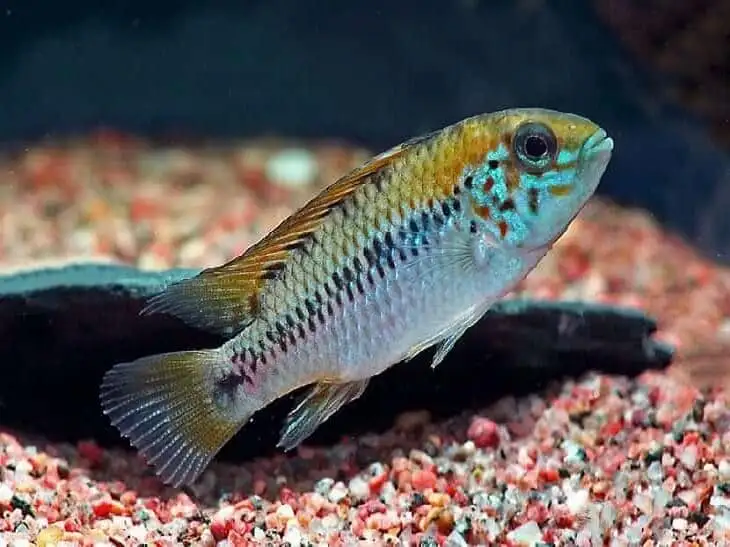Apistogramma steindachneri

Apistogramma steindachneri was first described in 1908 and named after the Viennese ichthyologist Franz Steindachneri. This fish was called differently in different periods of time. In 1936 it was called Apistogramma ornatipinnis, and in 1960 as Apistogramma wickleri. Under natural conditions, the fish lives in the Surinam River flowing in South America (Surinam, Guyana and Venezuela). Apistogramma steindachneri stick to muddy areas with a substrate of fallen leaves. Keeping these fish is recommended for experienced aquarists.
Apistogramma steindachneri is among the larger species of apistogramma. Males can reach a length of almost 10 cm, and its tail plumage, lyre-shaped, is half the length of the fish body. Young fish have a silvery blue coloration, with a black longitudinal stripe on the body. Adult fish have gray coloration. The size of females does not exceed 5 cm. Their coloration is yellow. In the central part of their body they have a black spot, and the head has a diagonal stripe.
In the aquarium Apistogramma steindachneri is usually quite easy to keep and breed. Keep fish preferably a small harem consisting of 1 male and 3-4 females. To contain a pair of fish requires an aquarium of 50 liters.
Males can be very aggressive, so the aquarium should be a few shelters so that females can hide. When keeping more than 1 male may be a problem, because the dominant male will constantly chase a weaker opponent and may eventually beat him to death. If there is still the desire to contain multiple males in one aquarium, then in this case they should be quite a lot. In this situation, the aggression will spread between the flock of fish, and no one will seriously hurt. It is fair to say that the beauty and behavior of these fish can be truly appreciated if you keep them in a large flock.
Water parameters: temperature 20-25° C, hardness dH 0-10°, acidity pH 4,0-7,5. Water filtration and aeration is necessary, but the water flow should be small. Twice a week, you need to replace 1/5 of the aquarium water with fresh.
Lighting is subdued, the intensity of about 0.3 W / L. The duration of daylight hours 8-10 hours a day.
The fish are fed chironomid, daphnia and artemia in frozen and live form. Do not refuse to fish and dry food in the form of flakes and pellets. Feed the fish should be 1-2 times a day.
Reproduction
During the spawning season, the male becomes near the shelter and begins in every way to attract the attention of females. When female swims into the shelter, she hatches eggs (150-200 eggs) in the cracks or on the walls of hiding places. The male immediately fertilizes the eggs and his concern for future offspring ends. He leaves the hiding place, and the female remains to take care of the clutch.
The eggs are incubated for 1.5-3 days.
Depending on the temperature, the incubation period lasts 36-72 hours. Hatch fry begin to swim in a friendly flock after 2-3 days.
The fry are fed live dust and artemia.
Life expectancy Apistogramma steindachneri in aquarium conditions is about 5-6 years.







